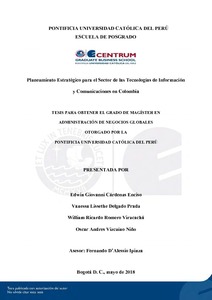| dc.contributor.advisor | D’Alessio Ipinza, Fernando Antonio | |
| dc.contributor.author | Cárdenas Enciso, Edwin Giovanni | es_ES |
| dc.contributor.author | Delgado Prada, Vanessa Lissethe | es_ES |
| dc.contributor.author | Romero Viracachá, William Ricardo | es_ES |
| dc.contributor.author | Vizcaíno Niño, Oscar Andres | es_ES |
| dc.date.accessioned | 2018-07-30T22:14:05Z | |
| dc.date.available | 2018-07-30T22:14:05Z | |
| dc.date.created | 2018 | |
| dc.date.issued | 2018-07-30 | |
| dc.identifier.uri | http://hdl.handle.net/20.500.12404/12363 | |
| dc.description.abstract | El sector de las Tecnologías de Información y de las Comunicaciones (TIC) en
Colombia es transversal a todas las industrias del país, llegando a aportar en 2016 el 3.01%
del producto bruto interno (PBI) y a ocupar el puesto 5 en Latinoamérica según el Índice
Global de Innovación (GII, por sus siglas en inglés) y el puesto 83 entre 175 en el Índice de
Desarrollo (IDI) en 2017. Es un sector en continua evolución dentro de un mercado creciente
en los subsectores de software, servicios de TI, y hardware y, en un mercado maduro en el
subsector de telecomunicaciones. Sin embargo, enfrenta hoy los retos de las tecnologías
emergentes, la economía digital, y la competitividad global que traen consigo para el país,
necesidades como el desarrollo de nuevas competencias para la fuerza laboral, ajustes a la
legislación tecnológica, mayores niveles de penetración y apropiación de las TIC, incremento
de la inversión en I+D, y superar los desafíos de una economía de lento crecimiento.
En el presente documento, se desarrolla el Planeamiento Estratégico para el Sector de
las TIC en Colombia, comenzando por un análisis macro del sector en el mundo, luego en la
región latinoamericana, y finalmente revisando las condiciones políticas, económicas,
sociales, tecnológicas, y ecológicas del entorno colombiano y de su potencial como país,
identificando las oportunidades y amenazas existentes, así como sus fortalezas y debilidades,
para así llegar a la definición de los objetivos a largo y corto plazo y las estrategias necesarias
para alcanzar la visión propuesta.
Se retuvieron 15 estrategias finales que se enfocaron principalmente en el desarrollo
de habilidades TIC, el mejoramiento de la infraestructura y de su cobertura en el ámbito
nacional, la ampliación del portafolio de bienes y servicios de alta calidad y competitividad
que generen más bienestar, empleo, e inclusión social, la obtención de mayores niveles de
captación de inversión, y en el incremento de la capacidad de investigación e innovación para
el desarrollo del sector | es_ES |
| dc.description.abstract | The Information and Communications Technology (ICT) sector in Colombia is crossindustry
all over the country, contributed to the 3.01% of the GDP by 2016 and it was ranked
as number 5 in Latin America according to the Global Innovation Index (GII) and 83rd out of
175 countries in the IDI Development Index at 2017. It is a sector in continuous evolution in
a growing market for the subsectors of software, IT services and hardware and in a mature
subsector of telecommunications. However, nowadays, the emerging economies, the digital
economy and the global competitiveness bring for the country the need to develop new
competencies for the labor force, adjustments to the technological legislation, higher levels of
penetration and appropriation of ICT, increased investment in R&D and overcome the
challenges of a slow-growing economy.
This document presents the Strategic Planning developed for the Information and
Communication Technologies Sector of Colombia, starting with a world-wide macro analysis
of the sector, then for the Latin American region and finally of the political, social,
technological conditions and ecological aspects of the Colombian environment and the
country potential, identifying current opportunities and threats, as well as the strengths and
weaknesses of the sector, in order to define long and short-term objectives and the needed
strategies to achieve the vision proposed.
Fifteen final strategies were retained that focus mainly on the development of ICT
skills, the improvement of infrastructure and coverage at the national level, the expansion of a
high quality and competitive goods and services portfolio that generates more well-being,
employment and social inclusion, obtaining higher levels of investment and increasing
research and innovation capacity that contributes to the development of the sector | es_ES |
| dc.language.iso | spa | es_ES |
| dc.publisher | Pontificia Universidad Católica del Perú | es_ES |
| dc.rights | info:eu-repo/semantics/openAccess | es_ES |
| dc.rights.uri | http://creativecommons.org/licenses/by-nc-nd/2.5/pe/ | * |
| dc.subject | Tecnologías de la información -- Colombia | es_ES |
| dc.subject | Telecomunicaciones -- Colombia | es_ES |
| dc.subject | Planificación estratégica | es_ES |
| dc.title | Planeamiento estratégico para el sector de las tecnologías de información y comunicaciones en Colombia | es_ES |
| dc.type | info:eu-repo/semantics/masterThesis | es_ES |
| thesis.degree.name | Maestro en Administración de Negocios Globales | es_ES |
| thesis.degree.level | Maestría | es_ES |
| thesis.degree.grantor | Pontificia Universidad Católica del Perú. CENTRUM | es_ES |
| thesis.degree.discipline | Administración de Negocios Globales | es_ES |
| renati.advisor.dni | 41319855 | |
| renati.advisor.orcid | https://orcid.org/0000-0002-4242-1220 | es_ES |
| renati.discipline | 413307 | es_ES |
| renati.level | https://purl.org/pe-repo/renati/level#maestro | es_ES |
| renati.type | https://purl.org/pe-repo/renati/type#tesis | es_ES |
| dc.publisher.country | PE | es_ES |
| dc.subject.ocde | https://purl.org/pe-repo/ocde/ford#5.02.04 | es_ES |






